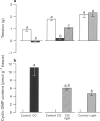Abstract
1. We have previously found that carbon monoxide (CO) potently relaxes the lamb ductus arteriosus and have ascribed this response to inhibition of a cytochrome P450-based mono-oxygenase reaction which sustains contractile tone. Our proposal, however, has been questioned on the evidence of findings in other blood vessels implicating the guanylyl cyclase-based relaxing mechanism as the target for CO. To investigate this issue further, we have carried out experiments in the isolated ductus from near-term foetal lambs and have examined the effect of CO concomitantly on muscle tone and cyclic GMP content, both in the absence and presence of guanylyl inhibitors, or during exposure to monochromatic light at 450 nm. 2. CO (65 microM) reversed completely, or nearly completely, the tone developed by the vessel in the presence of oxygen (30%) and indomethacin (2.8 microM). Cyclic GMP content tended to increase with the relaxation, but the change did not reach significance. Sodium nitroprusside (SNP), a NO donor, mimicked CO in relaxing the ductus. Contrary to CO, however, SNP caused a marked accumulation of cyclic GMP with levels being positively correlated with the relaxation. 3. Methylene blue (10 microM) reduced marginally the CO relaxation, whilst LY-83583 (10 microM) had an obvious, albeit variable, inhibitory effect. Basal cyclic GMP content was lower in tissues treated with either compound and rose upon exposure to CO. However, the levels attained were still within the range of values for tissues prior to any treatment. Furthermore, the elevation in cyclic GMP was not related to the magnitude of the CO relaxation. 4. Illumination of the ductus with monochromatic light at 450 nm reversed the CO relaxation and any concomitant increase in cyclic GMP. In the absence of CO, light by itself had no effect. 5. Ductal preparation with only muscle behaved as the intact preparations in reacting to CO, both in the absence and presence of guanylyl cyclase inhibitors, or during illumination. 6. We conclude that the primary action of CO in the ductus arteriosus is not exerted on the guanylyl cyclase heme and that cyclic GMP may only have an accessory role in the relaxation to this agent. This finding reasserts the importance of a cytochrom P450-based mono-oxygenase reaction for generation of tone and as a target for CO in the ductus.
Full text
PDF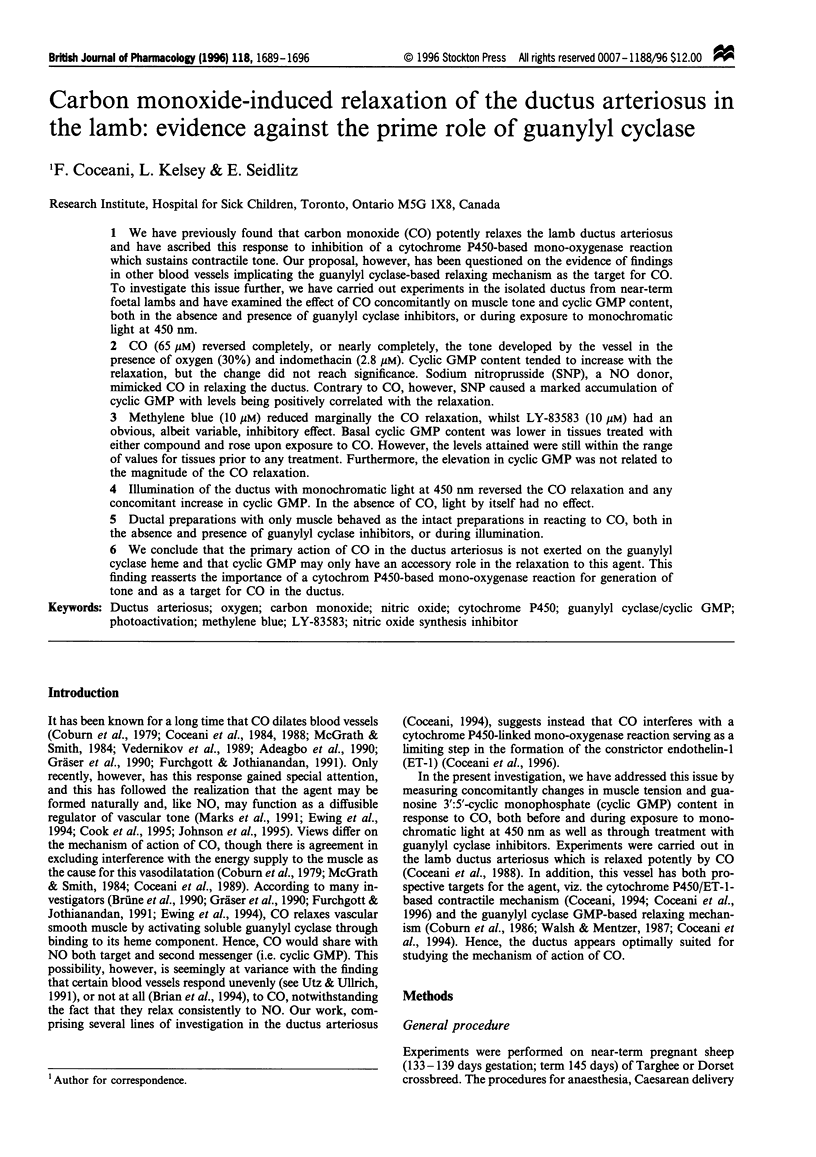
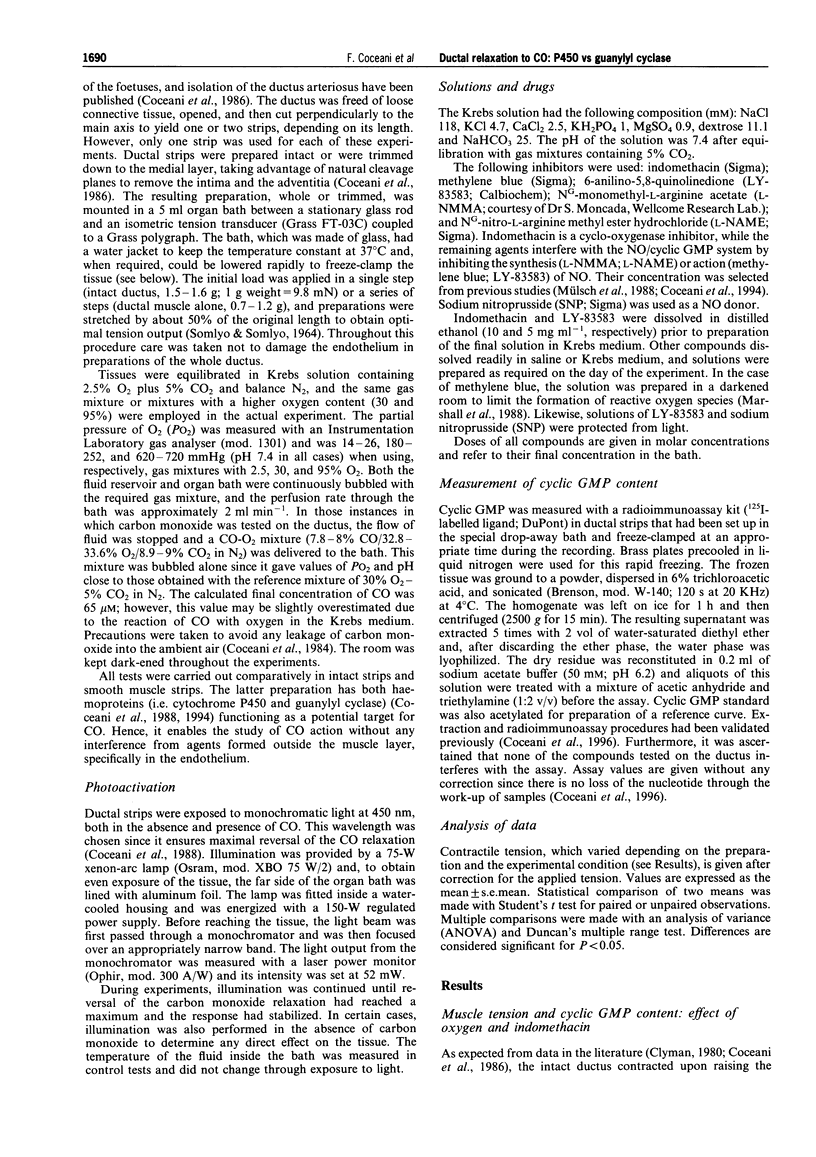
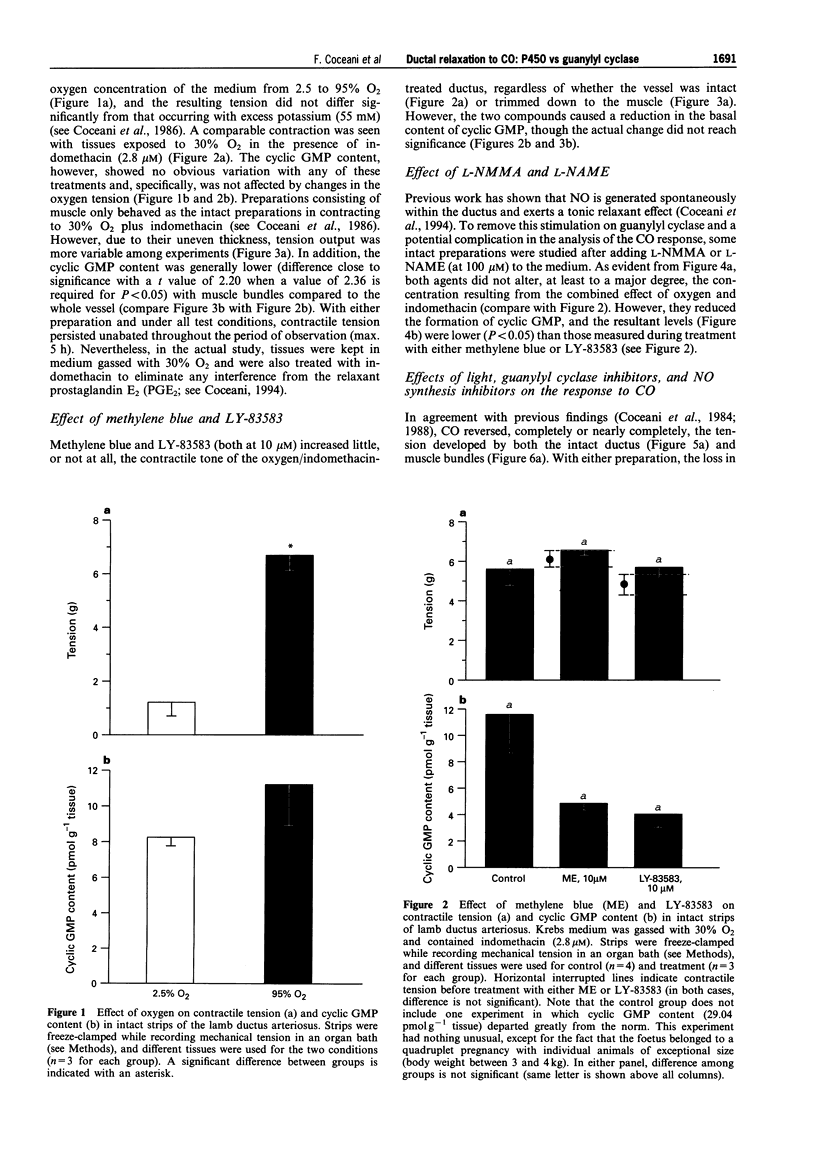
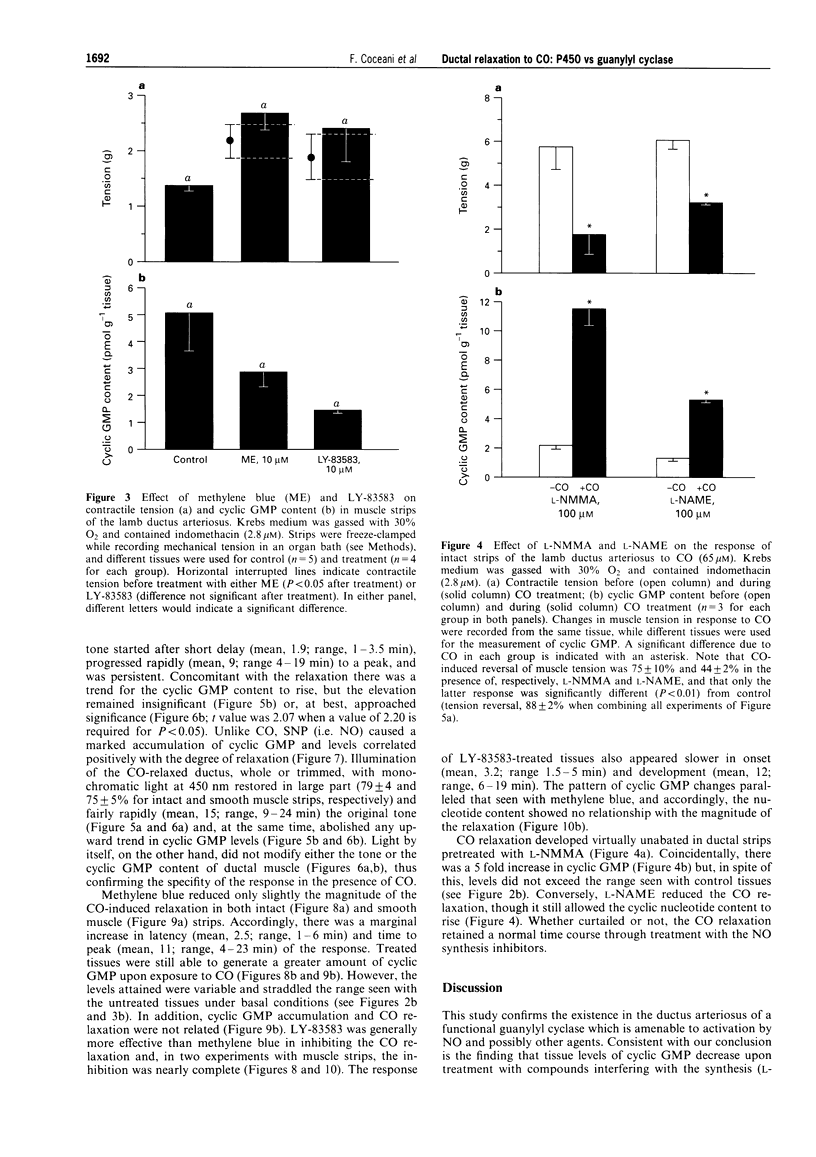
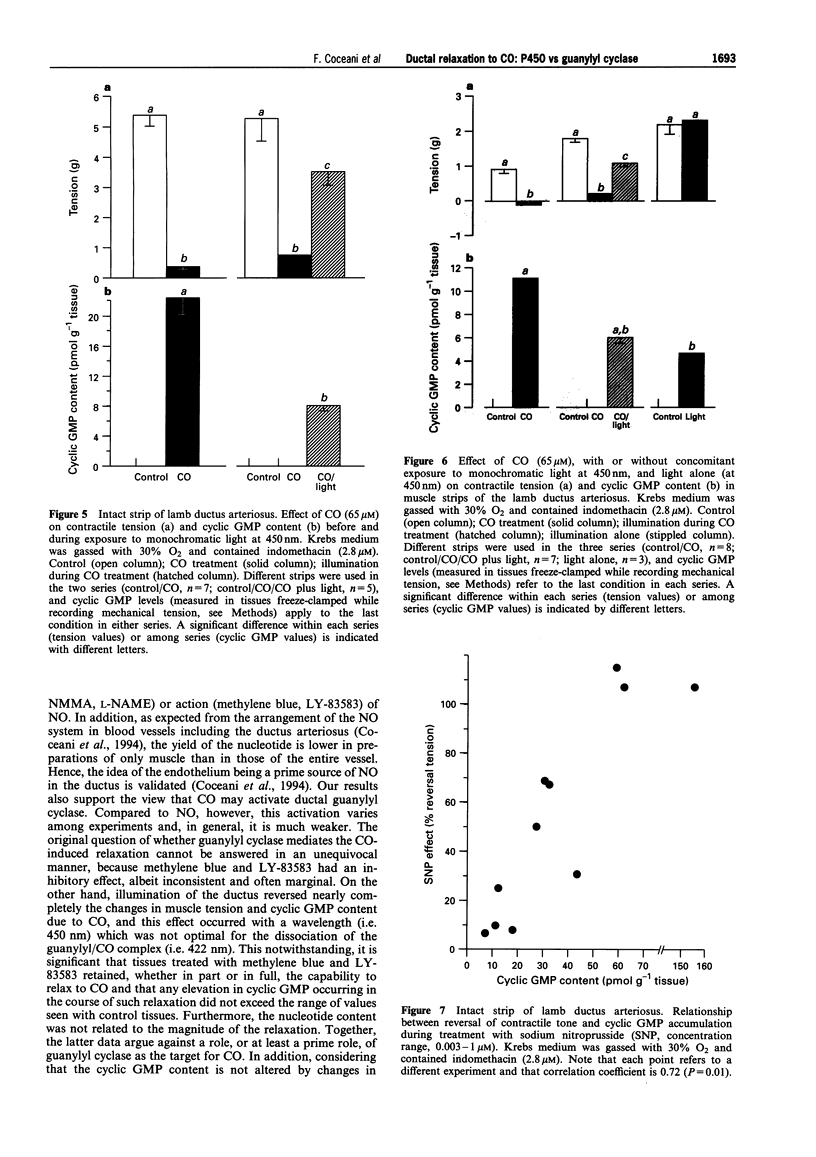
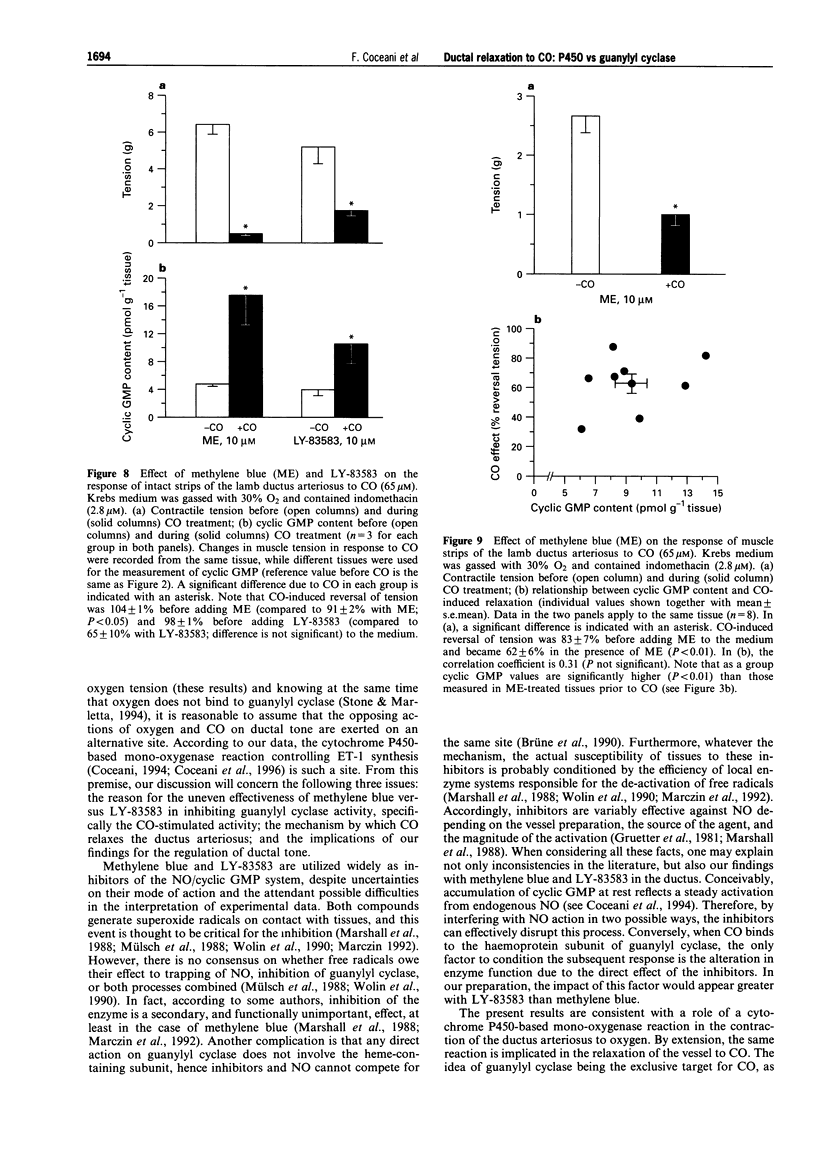
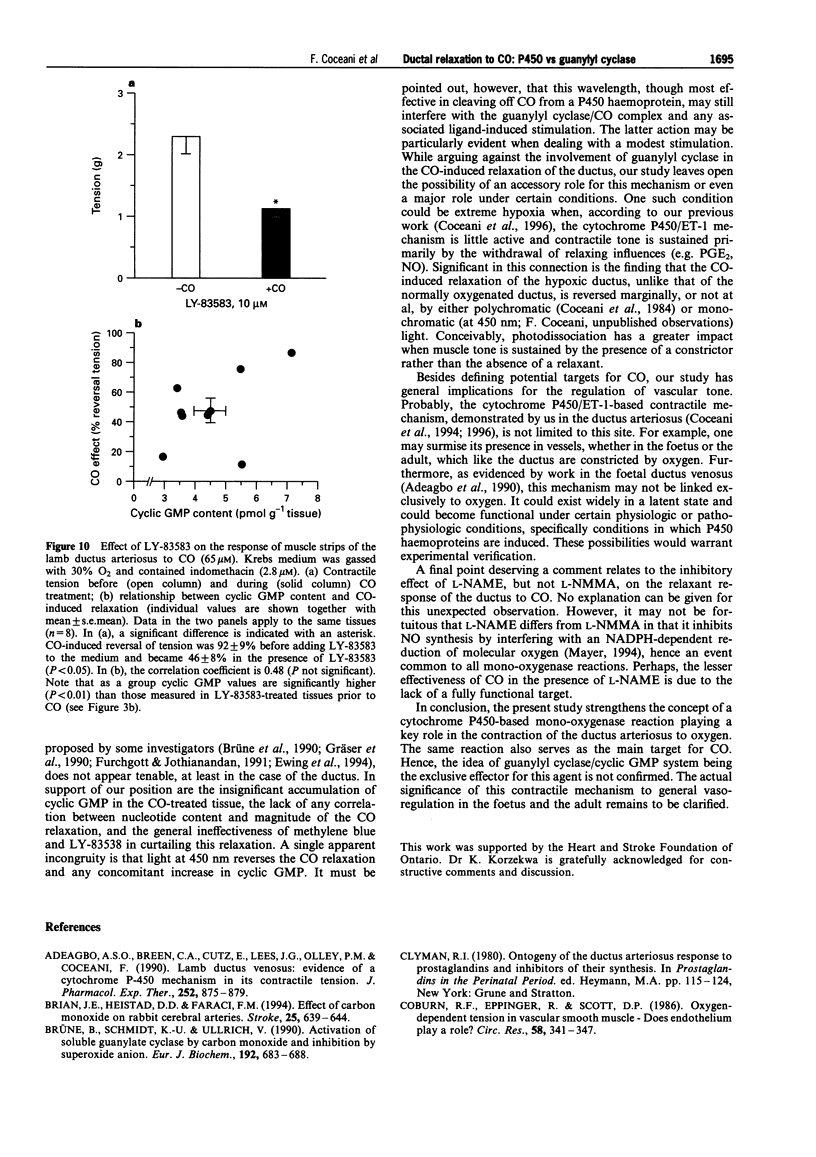
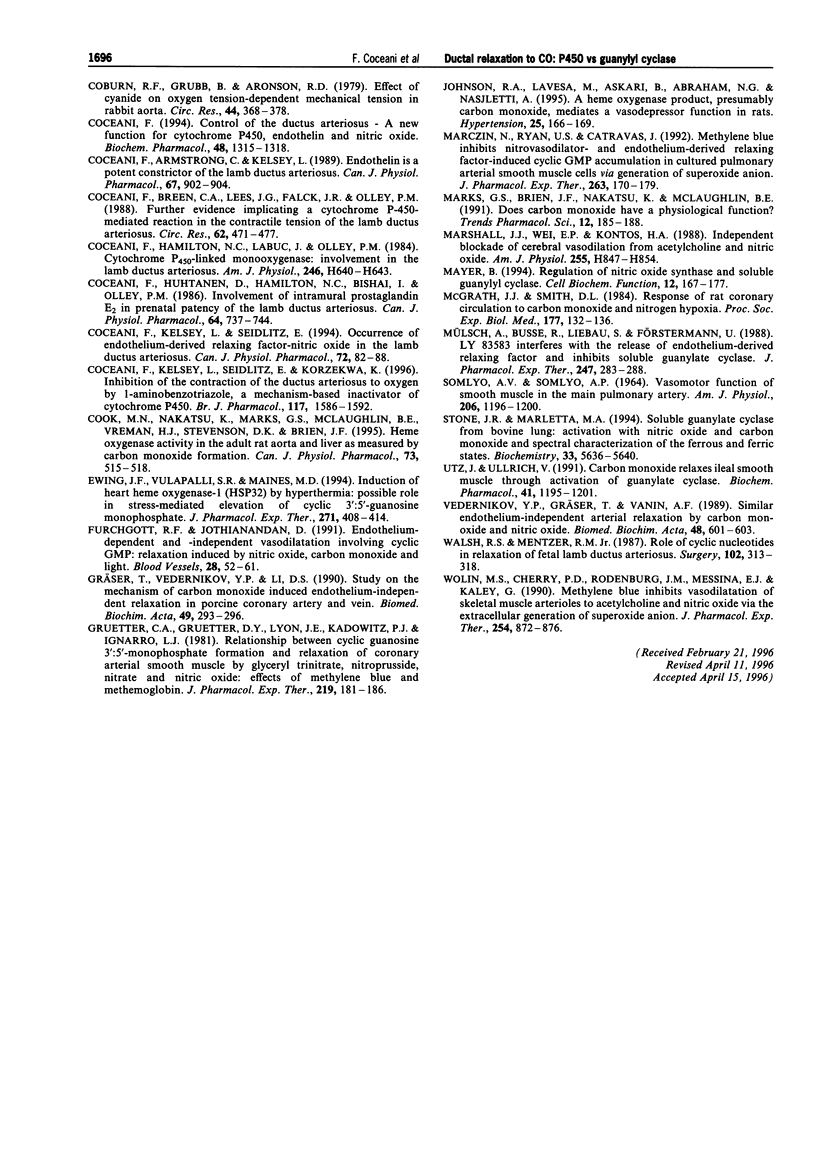
Images in this article
Selected References
These references are in PubMed. This may not be the complete list of references from this article.
- Adeagbo A. S., Breen C. A., Cutz E., Lees J. G., Olley P. M., Coceani F. Lamb ductus venosus: evidence of a cytochrome P-450 mechanism in its contractile tension. J Pharmacol Exp Ther. 1990 Feb;252(2):875–879. [PubMed] [Google Scholar]
- Brian J. E., Jr, Heistad D. D., Faraci F. M. Effect of carbon monoxide on rabbit cerebral arteries. Stroke. 1994 Mar;25(3):639–644. doi: 10.1161/01.str.25.3.639. [DOI] [PubMed] [Google Scholar]
- Brüne B., Schmidt K. U., Ullrich V. Activation of soluble guanylate cyclase by carbon monoxide and inhibition by superoxide anion. Eur J Biochem. 1990 Sep 24;192(3):683–688. doi: 10.1111/j.1432-1033.1990.tb19276.x. [DOI] [PubMed] [Google Scholar]
- Clyman R. I. Ontogeny of the ductus arteriosus response to prostaglandins and inhibitors of their synthesis. Semin Perinatol. 1980 Apr;4(2):115–124. [PubMed] [Google Scholar]
- Coburn R. F., Eppinger R., Scott D. P. Oxygen-dependent tension in vascular smooth muscle. Does the endothelium play a role? Circ Res. 1986 Mar;58(3):341–347. doi: 10.1161/01.res.58.3.341. [DOI] [PubMed] [Google Scholar]
- Coburn R. F., Grubb B., Aronson R. D. Effect of cyanide on oxygen tension-dependent mechanical tension in rabbit aorta. Circ Res. 1979 Mar;44(3):368–378. doi: 10.1161/01.res.44.3.368. [DOI] [PubMed] [Google Scholar]
- Coceani F., Armstrong C., Kelsey L. Endothelin is a potent constrictor of the lamb ductus arteriosus. Can J Physiol Pharmacol. 1989 Aug;67(8):902–904. doi: 10.1139/y89-141. [DOI] [PubMed] [Google Scholar]
- Coceani F., Breen C. A., Lees J. G., Falck J. R., Olley P. M. Further evidence implicating a cytochrome P-450-mediated reaction in the contractile tension of the lamb ductus arteriosus. Circ Res. 1988 Mar;62(3):471–477. doi: 10.1161/01.res.62.3.471. [DOI] [PubMed] [Google Scholar]
- Coceani F. Control of the ductus arteriosus--a new function for cytochrome P450, endothelin and nitric oxide. Biochem Pharmacol. 1994 Oct 7;48(7):1315–1318. doi: 10.1016/0006-2952(94)90552-5. [DOI] [PubMed] [Google Scholar]
- Coceani F., Hamilton N. C., Labuc J., Olley P. M. Cytochrome P 450-linked monooxygenase: involvement in the lamb ductus arteriosus. Am J Physiol. 1984 Apr;246(4 Pt 2):H640–H643. doi: 10.1152/ajpheart.1984.246.4.H640. [DOI] [PubMed] [Google Scholar]
- Coceani F., Huhtanen D., Hamilton N. C., Bishai I., Olley P. M. Involvement of intramural prostaglandin E2 in prenatal patency of the lamb ductus arteriosus. Can J Physiol Pharmacol. 1986 Jun;64(6):737–744. doi: 10.1139/y86-124. [DOI] [PubMed] [Google Scholar]
- Coceani F., Kelsey L., Seidlitz E., Korzekwa K. Inhibition of the contraction of the ductus arteriosus to oxygen by 1-aminobenzotriazole, a mechanism-based inactivator of cytochrome P450. Br J Pharmacol. 1996 Apr;117(7):1586–1592. doi: 10.1111/j.1476-5381.1996.tb15325.x. [DOI] [PMC free article] [PubMed] [Google Scholar]
- Coceani F., Kelsey L., Seidlitz E. Occurrence of endothelium-derived relaxing factor--nitric oxide in the lamb ductus arteriosus. Can J Physiol Pharmacol. 1994 Jan;72(1):82–88. doi: 10.1139/y94-013. [DOI] [PubMed] [Google Scholar]
- Cook M. N., Nakatsu K., Marks G. S., McLaughlin B. E., Vreman H. J., Stevenson D. K., Brien J. F. Heme oxygenase activity in the adult rat aorta and liver as measured by carbon monoxide formation. Can J Physiol Pharmacol. 1995 Apr;73(4):515–518. doi: 10.1139/y95-065. [DOI] [PubMed] [Google Scholar]
- Ewing J. F., Raju V. S., Maines M. D. Induction of heart heme oxygenase-1 (HSP32) by hyperthermia: possible role in stress-mediated elevation of cyclic 3':5'-guanosine monophosphate. J Pharmacol Exp Ther. 1994 Oct;271(1):408–414. [PubMed] [Google Scholar]
- Furchgott R. F., Jothianandan D. Endothelium-dependent and -independent vasodilation involving cyclic GMP: relaxation induced by nitric oxide, carbon monoxide and light. Blood Vessels. 1991;28(1-3):52–61. doi: 10.1159/000158843. [DOI] [PubMed] [Google Scholar]
- Gruetter C. A., Gruetter D. Y., Lyon J. E., Kadowitz P. J., Ignarro L. J. Relationship between cyclic guanosine 3':5'-monophosphate formation and relaxation of coronary arterial smooth muscle by glyceryl trinitrate, nitroprusside, nitrite and nitric oxide: effects of methylene blue and methemoglobin. J Pharmacol Exp Ther. 1981 Oct;219(1):181–186. [PubMed] [Google Scholar]
- Gräser T., Vedernikov Y. P., Li D. S. Study on the mechanism of carbon monoxide induced endothelium-independent relaxation in porcine coronary artery and vein. Biomed Biochim Acta. 1990;49(4):293–296. [PubMed] [Google Scholar]
- Johnson R. A., Lavesa M., Askari B., Abraham N. G., Nasjletti A. A heme oxygenase product, presumably carbon monoxide, mediates a vasodepressor function in rats. Hypertension. 1995 Feb;25(2):166–169. doi: 10.1161/01.hyp.25.2.166. [DOI] [PubMed] [Google Scholar]
- Marczin N., Ryan U. S., Catravas J. D. Methylene blue inhibits nitrovasodilator- and endothelium-derived relaxing factor-induced cyclic GMP accumulation in cultured pulmonary arterial smooth muscle cells via generation of superoxide anion. J Pharmacol Exp Ther. 1992 Oct;263(1):170–179. [PubMed] [Google Scholar]
- Marks G. S., Brien J. F., Nakatsu K., McLaughlin B. E. Does carbon monoxide have a physiological function? Trends Pharmacol Sci. 1991 May;12(5):185–188. doi: 10.1016/0165-6147(91)90544-3. [DOI] [PubMed] [Google Scholar]
- Marshall J. J., Wei E. P., Kontos H. A. Independent blockade of cerebral vasodilation from acetylcholine and nitric oxide. Am J Physiol. 1988 Oct;255(4 Pt 2):H847–H854. doi: 10.1152/ajpheart.1988.255.4.H847. [DOI] [PubMed] [Google Scholar]
- Mayer B. Regulation of nitric oxide synthase and soluble guanylyl cyclase. Cell Biochem Funct. 1994 Sep;12(3):167–177. doi: 10.1002/cbf.290120304. [DOI] [PubMed] [Google Scholar]
- McGrath J. J., Smith D. L. Response of rat coronary circulation to carbon monoxide and nitrogen hypoxia. Proc Soc Exp Biol Med. 1984 Oct;177(1):132–136. doi: 10.3181/00379727-177-41922. [DOI] [PubMed] [Google Scholar]
- Mülsch A., Busse R., Liebau S., Förstermann U. LY 83583 interferes with the release of endothelium-derived relaxing factor and inhibits soluble guanylate cyclase. J Pharmacol Exp Ther. 1988 Oct;247(1):283–288. [PubMed] [Google Scholar]
- SOMLYO A. V., SOMLYO A. P. VASOMOTOR FUNCTION OF SMOOTH MUSCLE IN THE MAIN PULMONARY ARTERY. Am J Physiol. 1964 Jun;206:1196–1200. doi: 10.1152/ajplegacy.1964.206.6.1196. [DOI] [PubMed] [Google Scholar]
- Stone J. R., Marletta M. A. Soluble guanylate cyclase from bovine lung: activation with nitric oxide and carbon monoxide and spectral characterization of the ferrous and ferric states. Biochemistry. 1994 May 10;33(18):5636–5640. doi: 10.1021/bi00184a036. [DOI] [PubMed] [Google Scholar]
- Utz J., Ullrich V. Carbon monoxide relaxes ileal smooth muscle through activation of guanylate cyclase. Biochem Pharmacol. 1991 Apr 15;41(8):1195–1201. doi: 10.1016/0006-2952(91)90658-r. [DOI] [PubMed] [Google Scholar]
- Vedernikov Y. P., Gräser T., Vanin A. F. Similar endothelium-independent arterial relaxation by carbon monoxide and nitric oxide. Biomed Biochim Acta. 1989;48(8):601–603. [PubMed] [Google Scholar]
- Walsh R. S., Mentzer R. M., Jr Role of cyclic nucleotides in relaxation of fetal lamb ductus arteriosus. Surgery. 1987 Aug;102(2):313–318. [PubMed] [Google Scholar]
- Wolin M. S., Cherry P. D., Rodenburg J. M., Messina E. J., Kaley G. Methylene blue inhibits vasodilation of skeletal muscle arterioles to acetylcholine and nitric oxide via the extracellular generation of superoxide anion. J Pharmacol Exp Ther. 1990 Sep;254(3):872–876. [PubMed] [Google Scholar]



